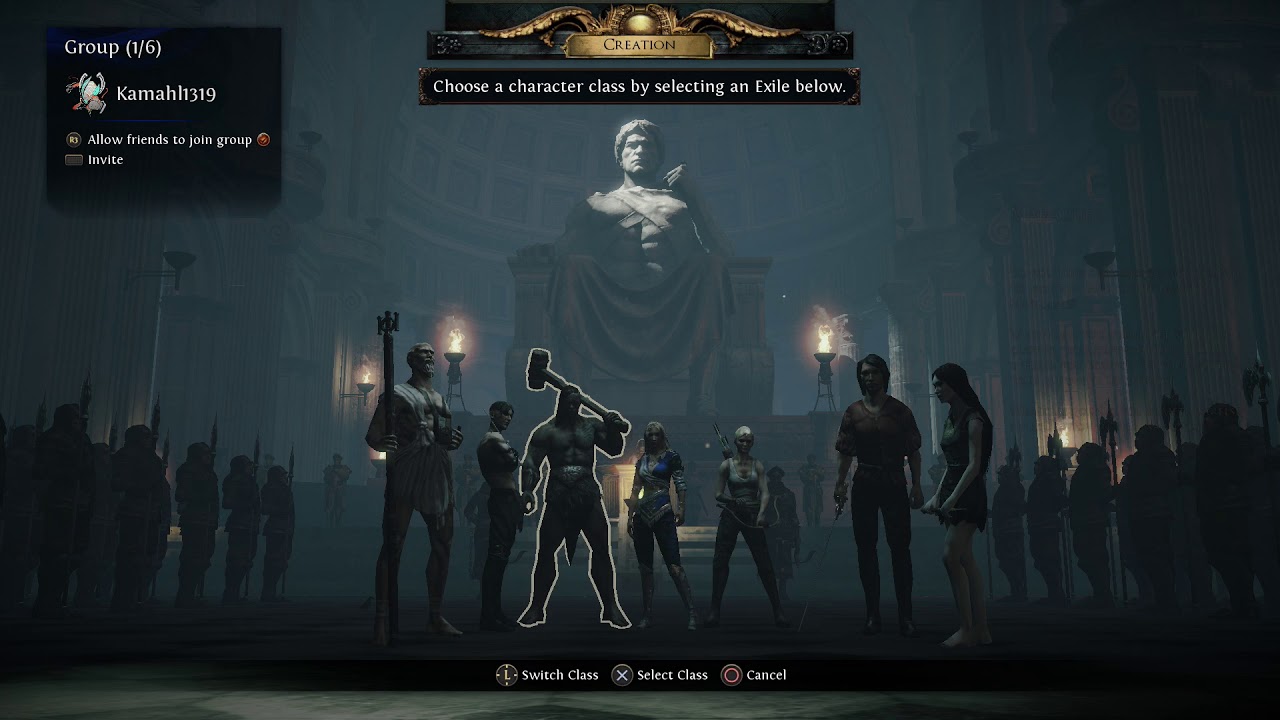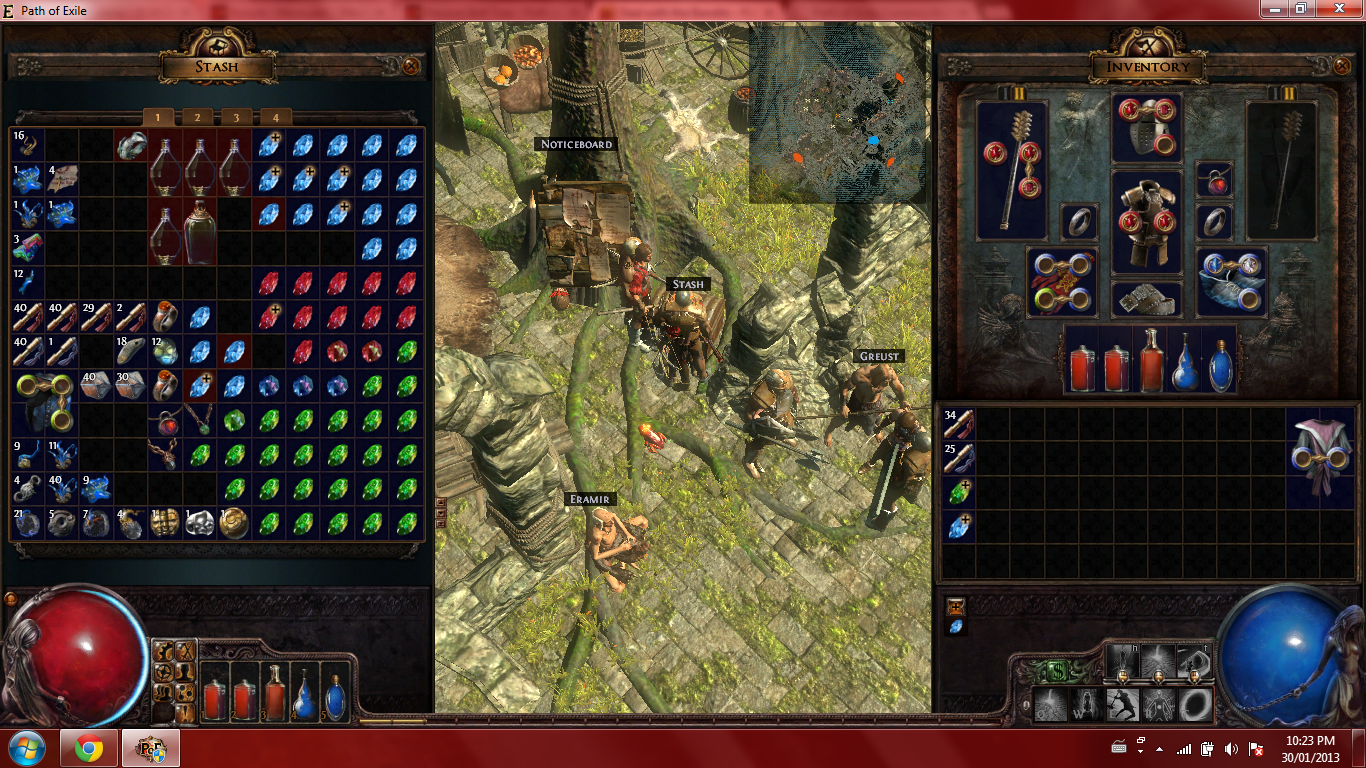For gamers, the Path Of Exile should be a fairly familiar title. It is “a competitive online action RPG” from Grinding Gear Games, based out of New Zealand since the middle of the last decade. With loads of characters, areas, and depth, plus extremely fair monetization, this is one free game that every RPG fan needs to try. You may be skeptical, so we specially prepared a Path of Exile Review for you, and judged from all aspects whether the game is worth your playing.
Story
First up, the story. Before diving into the game, you are required to select the character class that you are going to play as, and the name your character will have. There a few to choose from, as is normal in games like this, and they can be roughly split into melee and ranged classes.
The melee classes are the Marauder, who uses Maces to do immense damage and is a Strength-based character.
The ranged characters include the Ranger, who uses all manner of bows and is a Dexterity-based character, and the Witch, who is purely Intelligence focused and uses a wand or a scepter to bring magic-based pain.
There is another class that can be chosen, the Scion, but this requires progress through the game to unlock.
Then, after you’ve chosen who you’re going to be, comes to the joy of trying to come up with a name. These can’t contain spaces, so a forename and surname are right out, and it has to be unique. This is a weird design choice.
Characters and leagues
 Path of Exile features seven primary character classes, one of which (the Scion) unlocks after completing Act 3. They all have one or more subclasses, called Ascendancy classes. Here’s a breakdown.
Path of Exile features seven primary character classes, one of which (the Scion) unlocks after completing Act 3. They all have one or more subclasses, called Ascendancy classes. Here’s a breakdown.
• Duelist: He fights with melee attacks and can also summon an AI minion to fight alongside him.
• Templar: Fires projectiles, including three balls of lightning at once and a chain lightning attack.
• Witch: A female spellcaster with high intelligence.
• Ranger: She uses a bow and is extremely dexterous, but can wield swords as well. Despite being a glass cannon, the ranger is my class of choice.
• Marauder: A melee fighter with tremendous strength.
• Shadow: A dexterous and intelligent fighter, he uses short-range weapons and traps during battle.
• Scion: She can develop into any character build thanks to Path of Exile’s skill system. This makes her an advanced character, and she must be unlocked later in the game.
You can choose from 1 of 6 character classes, each of which uses, in some combination, 3 main attributes: strength, intelligence, and dexterity. You can play through the game with up to 5 other friends (or strangers), which I highly recommend doing. The game is fun to play by yourself, but it is a very fun multiplayer experience.
The game also offers various modes referred to as “Leagues”. Standard, Betrayal, and Hardcore Betrayal. At least they’re the Leagues available right now – after the new Betrayal expansion hit the live server.
Leagues, essentially, represent individual game worlds that your player exists and plays through. You play alongside other players in the same league as you and cannot interact with anyone outside that specific league.
Skills and respecs
There is lots of loot with many different modifiers, randomized maps, and a skill/leveling system second to none. The robust passive tree is both the game’s greatest strength and the largest barrier to newcomers.
It would not be an exaggeration to say that there are hundreds of nodes available to shape your character as you level. This, combined with unique items, creates endless possibilities for builds. Also, it is worth noting all characters have access to the same passive tree. You can mix and match abilities by unlocking skills along with various branches, but this creates an opportunity cost compared to sticking with the character’s native abilities.
Gameplay and combat
Path of Exile is a Diablo-style action-RPG with an emphasis on exploration and loot collection over combat. It also features minor MMO elements, such as public towns in which players can meet and group up or trade items.
By holding the Right Trigger, players can access the second set of skills. You can access eight skills using just the face buttons and one trigger, freeing up the other three buttons for other tasks.
The combat mostly feels tight, with lots of variation between the many character classes. During fights, your character autotargets enemies and might not always target the closest threat.
Potions that restore health and provide other benefits are assigned to both bumper buttons and three directions on the D-Pad, providing quick access to five total items. Tapping down on the D-Pad toggles the map overlay, facilitating navigation of Path of Exile’s tremendous randomly-generated environments. The game also displays a minimap in the corner of the screen.
Inventory management is another area in which Path of Exile’s developers deviated from the standard Diablo template. Every piece of loot you acquire takes up varying amounts of space in your bag. To carry as many possible things at once, you have to move items around and squeeze things into the allotted spaces.
You’ll basically pick up fewer items than in other games, focusing on loot that specifically benefits your character or has a high value. Not picking up every single thing takes some getting used to, but it actually benefits the pace of the game.
Players will rely on two basic types of consumable scrolls as well. Identification scrolls do what they do in every RPG: identify rare items. Portal scrolls create portals to town.
Gems
 Another very nicely implemented facet of the game is the use of gems. Gems can be found in one of three colors and can be placed into a matching colored socket on any of your items. Any gem in the socket of an equipped item will begin to build experience. Gems give both passive and active skills to your character. The more experience gained while a gem is equipped, the more experience the gem gains, thus increasing its level, As a result, your character will become more proficient at the associated skill, increasing the benefit of the ability, and thus making your character better. Gem sockets may be connected, allowing you to place passive gems next to active gems to increase the effect of the active gem’s skill. This aspect of the game also makes finding the right items more difficult since you may be limited, based on your style of play, to certain combinations of gem slots on each item.
Another very nicely implemented facet of the game is the use of gems. Gems can be found in one of three colors and can be placed into a matching colored socket on any of your items. Any gem in the socket of an equipped item will begin to build experience. Gems give both passive and active skills to your character. The more experience gained while a gem is equipped, the more experience the gem gains, thus increasing its level, As a result, your character will become more proficient at the associated skill, increasing the benefit of the ability, and thus making your character better. Gem sockets may be connected, allowing you to place passive gems next to active gems to increase the effect of the active gem’s skill. This aspect of the game also makes finding the right items more difficult since you may be limited, based on your style of play, to certain combinations of gem slots on each item.
Fair Microtransactions and Monetization
Path of Exile is a free-to-play game that has truly been designed to be completely playable for free, without creating any disadvantages or obstacles for players. Of course, the developers need to make money, so there are still a number of highly optional things to buy with premium currency. Tips: you can buy cheap PoE currency via Eznpc for safe trading, fast delivery, and you can trust it!
The most useful ones include a variety of stash tabs for $3 and up, allowing players to store a larger quantity of items for all of their characters to access. Character slots are $3 and are also useful for hardcore fans of the game. Beyond that, you can buy a lot of expensive cosmetic items and effects.
Final Verdict
In closing, I cannot recommend this game enough. The game currently already has solid gameplay, hours of content, infinite build possibilities, and one of the best business models for a free-to-play game. Also, every few months there is a large new patch that introduces a new aspect to the game. In terms of a numerical score, I’d give Path of Exile a 9 out of 10 and would encourage everyone to check it out on Steam, even if it isn’t in your genre of choice. Considering that it’s both free and quite probably the best ARPG that we’ll ever see, I can think of no valid excuse not to give it a whirl.
Path of Exile is a game that costs nothing, but you can get a lot of fun in the process of playing. Do you want to try it? Also, for more guidance on the Path of Exile, click here.
